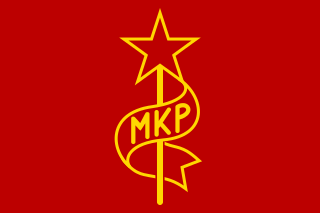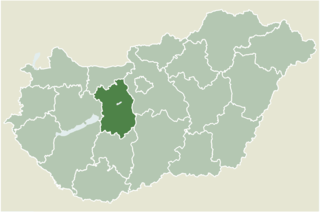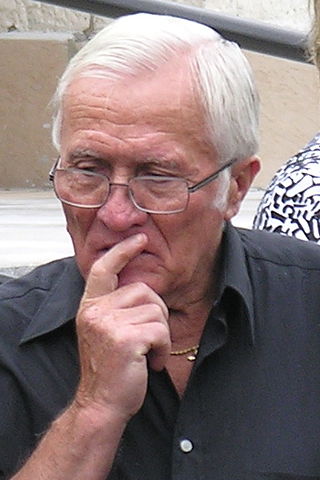The Objectivist poets were a loose-knit group of second-generation Modernists who emerged in the 1930s. They were mainly American and were influenced by, among others, Ezra Pound and William Carlos Williams. The basic tenets of objectivist poetics as defined by Louis Zukofsky were to treat the poem as an object, and to emphasize sincerity, intelligence, and the poet's ability to look clearly at the world. While the name of the group is similar to Ayn Rand's school of philosophy, the two movements are not affiliated.

Carl Rakosi was the last surviving member of the Objectivist poets, still publishing and performing poetry well into his 90s.

János József Kádár, born János József Czermanik, was a Hungarian Communist leader and the General Secretary of the Hungarian Socialist Workers' Party, a position he held for 32 years. Declining health led to his retirement in 1988, and he died in 1989 after being hospitalized for pneumonia.

László Rajk was a Hungarian Communist politician, who served as Minister of Interior and Minister of Foreign Affairs. He was an important organizer of the Hungarian Communists' power, but he eventually fell victim to Mátyás Rákosi's show trials.

Ernő Gerő was a Hungarian Communist leader in the period after World War II and briefly in 1956 the most powerful man in Hungary as the leader of its ruling communist party.

Mátyás Rákosi was a Hungarian communist politician who was the de facto leader of Hungary from 1947 to 1956. He served first as General Secretary of the Hungarian Communist Party from 1945 to 1948 and then as General Secretary of the Hungarian Working People's Party from 1948 to 1956.

The Hungarian Communist Party, known earlier as the Party of Communists in Hungary, was a communist party in Hungary that existed during the interwar period and briefly after World War II.

Lajos Dinnyés was a Hungarian politician of the Smallholders Party who served as the first pro-communist Prime Minister of the Second Hungarian Republic from 1947 to 1948.

The Hungarian People's Republic was a one-party socialist state from 20 August 1949 to 23 October 1989. It was governed by the Hungarian Socialist Workers' Party, which was under the influence of the Soviet Union. Pursuant to the 1944 Moscow Conference, Winston Churchill and Joseph Stalin had agreed that after the war Hungary was to be included in the Soviet sphere of influence. The HPR remained in existence until 1989, when opposition forces brought the end of communism in Hungary.
Goulash Communism, also known as refrigerator communism, Kádárism or the Hungarian Thaw, is the variety of state socialism in the Hungarian People's Republic following the Hungarian Revolution of 1956. During János Kádár's period of leadership, the Hungarian People's Republic implemented policies with the goal to create a high standard of living for the people of Hungary coupled with economic reforms. These reforms fostered a sense of well-being and relative cultural freedom in Hungary, giving it the reputation of being "the happiest barracks" of the Eastern Bloc during the 1960s to the 1970s. With elements of regulated market economics as well as an improved human rights record, it represented a quiet reform and deviation from the Stalinist principles applied to Hungary in the previous decade.

Mihály Farkas was a Hungarian Communist politician who served as Minister of National Defense of the Hungarian People's Republic.

Mátyásdomb is a village in Fejér county, Hungary. It got its name from Mátyás Rákosi, a former Hungarian leader.

Gyula Rákosi is a Hungarian former footballer.

The Second Hungarian Republic was a parliamentary republic briefly established after the disestablishment of the Kingdom of Hungary on 1 February 1946 and was itself dissolved on 20 August 1949. It was succeeded by the Soviet-backed Hungarian People's Republic.

Sándor Zöld was a Hungarian communist politician, who served as interior minister between 1950 and 1951. He followed János Kádár in this position.

The F-4 Object is a formerly secret nuclear shelter under the downtown of Budapest. It is located 45-50 metres below the surface, several kilometres long approximately in a "H" shape between Kossuth tér and Szabadság tér. It has a direct connection to the Line 2 of the Budapest Metro and a closed tunnel to the Hungarian Parliament Building. According to other sources, the bunker has a connection with the former headquarters of the Hungarian Working People's Party, and there is no tunnel to the Parliament Building.

Jenő Rákosi was a Hungarian writer, journalist, theater director, editor, and a member of Hungarian Academy of Sciences and Kisfaludy Society and a member of the Petőfi Association.
Béla Rákosi was a Hungarian physician, surgeon doctor, and police surgeon. He was a relative of Jenő, Viktor, and Szidi Rákosi.

Viktor Rákosi, also known under his pseudonym Sipulusz, was a Hungarian writer, journalist, humorist, member of parliament, and sport leader. His siblings include actor Szidi Rákosi and fellow writer Jenő Rákosi.

Szidi Rákosi was a Hungarian actress and acting teacher. Her relatives included Béla Rákosi, Jenő Rákosi, Viktor Rákosi and Ida Rákosi, the wife of Lajos Evva.




















